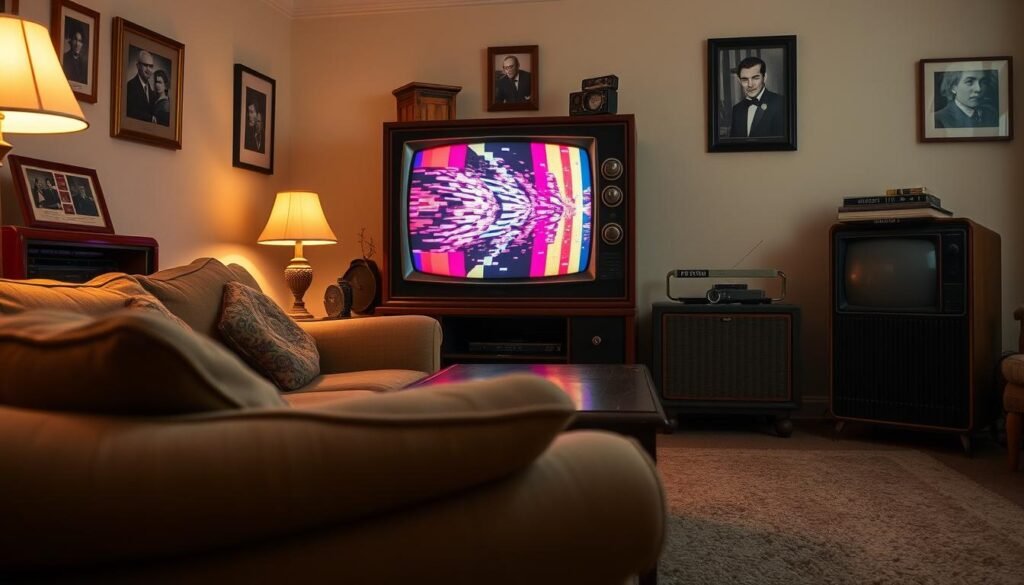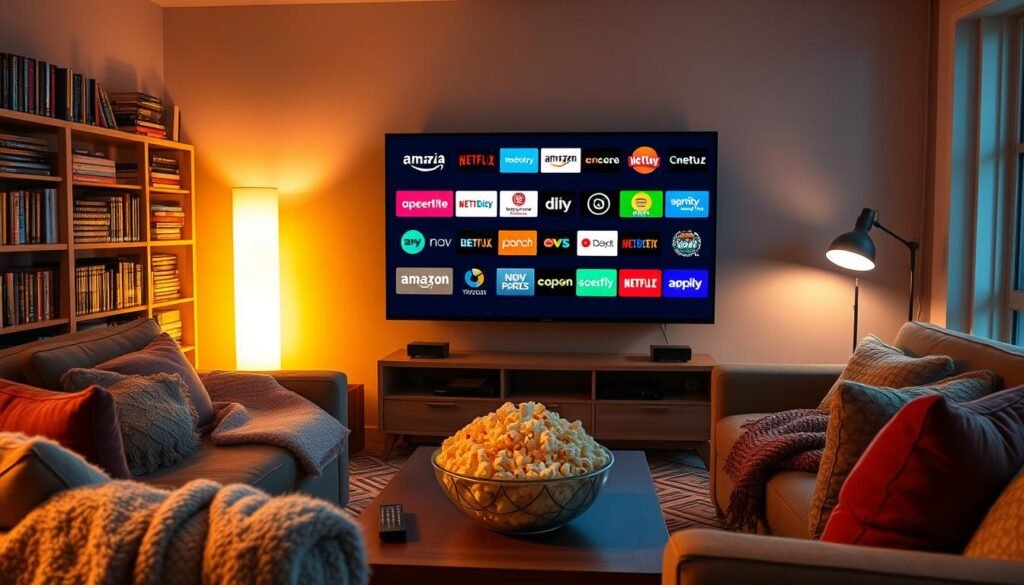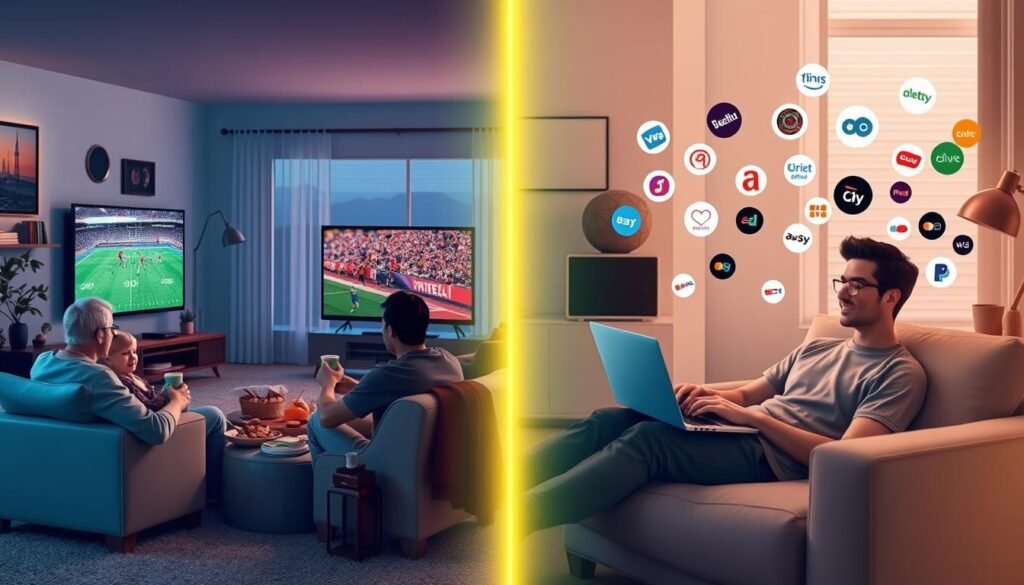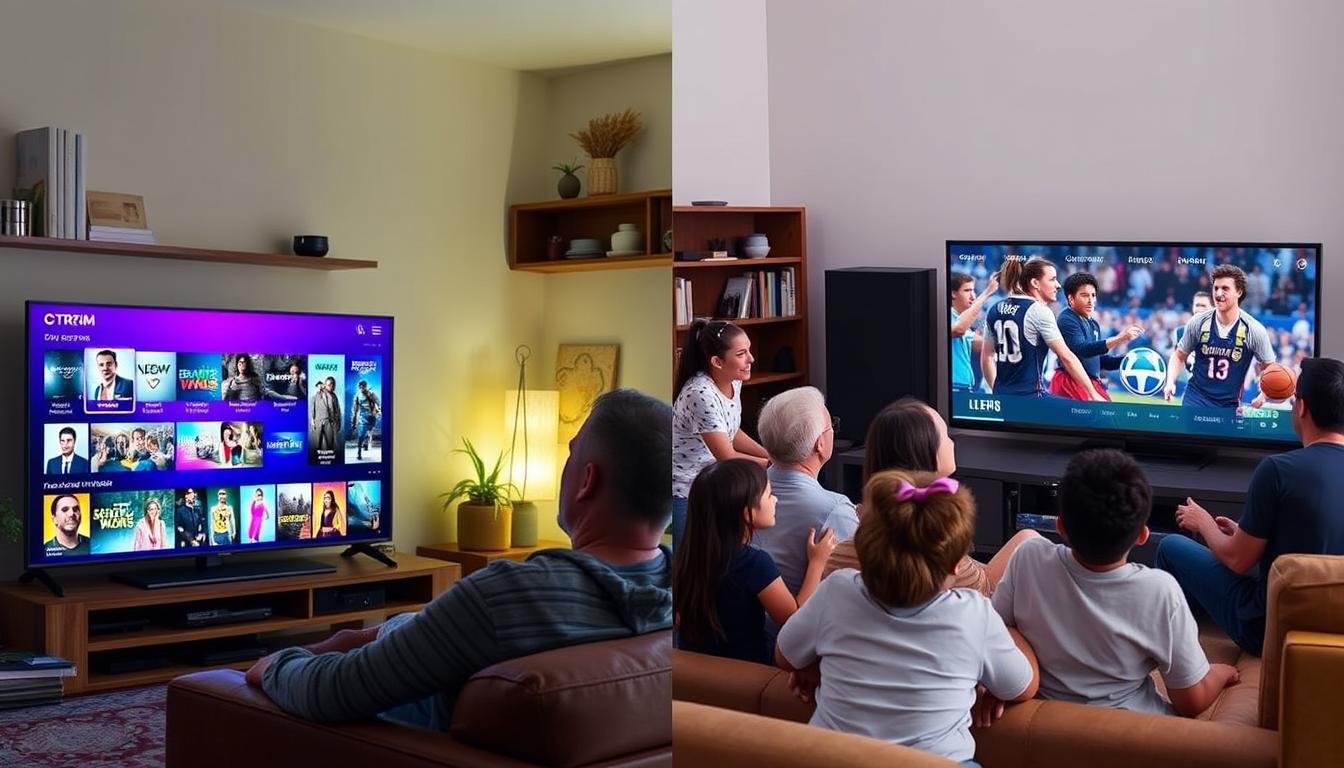In today’s world, we have many ways to watch our favourite shows. Video-on-demand (VOD) services have changed how we watch TV. They give us more control over what and when we watch.
It’s important to know the differences between VOD and live TV. This helps us choose what suits us best. Whether it’s VOD or live TV, it’s all about what we prefer and need.
Key Takeaways
- VOD services offer on-demand access to a vast library of content, allowing viewers to watch what they want, when they want.
- Live TV provides a more shared, real-time viewing experience, with the ability to engage with programmes and events as they unfold.
- VOD offers greater scheduling flexibility and personalisation, while live TV maintains the appeal of appointment viewing and community-based engagement.
- Subscription-based VOD platforms and over-the-top (OTT) services are gaining popularity, providing alternative options to traditional broadcast television.
- The future of television may involve a convergence of VOD and live TV, offering hybrid models that cater to diverse viewing preferences.
The Rise of Video-on-Demand (VOD)
Video-on-demand (VOD) has changed how we watch TV and movies. It lets us pick what we watch, when we want. This is different from traditional TV schedules.
Defining Video-on-Demand
Video-on-demand means you can stream or download shows and movies anytime. It’s popular because it lets you control your viewing experience.
Benefits of VOD Services
The growth of video-on-demand services has many benefits:
- Flexibility: You can watch what you like, when you like, pausing or rewinding.
- Personalisation: Services suggest shows based on what you like, making your viewing better.
- Expanded content library: You get to choose from a huge range of movies, TV shows, and more.
- Portability: You can watch on many devices, like TVs, phones, and tablets, making it easy to keep watching.
These benefits have made video-on-demand very popular. It’s changing how we watch TV and enjoy time-shifted viewing.
As over-the-top (OTT) platforms grow, TV watching will become even more personal. It will meet the changing needs and tastes of viewers.
Traditional Live TV: The Broadcast Experience
In today’s world of streaming and digital content, broadcast TV still has a big role. It offers a shared experience and real-time connection, unlike on-demand services. This makes it special for viewers.
“Appointment viewing” is key to live TV. People plan their day around their favourite shows. This creates a sense of community as everyone watches together. It’s perfect for discussions, social media chats, and big events.
Watching live TV also means discovering new shows by chance. While channel surfing, you might find something new and exciting. This adds a fun surprise to your viewing.
| Feature | Broadcast TV | VOD |
|---|---|---|
| Viewing Experience | Shared, real-time engagement | Individualised, on-demand |
| Scheduling | Appointment viewing | Flexible scheduling |
| Content Discovery | Channel surfing and serendipitous finds | Personalised recommendations |
VOD services offer more flexibility, but live TV’s unique charm keeps it popular. It continues to attract viewers in our changing media world.

VOD vs live TV: Flexibility and Control
Choosing between video-on-demand (VOD) and live TV depends on what you value most. VOD gives you the freedom to watch when you want, offering a more personal experience. Live TV, on the other hand, keeps the excitement of watching shows as they happen.
Scheduling Flexibility
VOD lets you watch shows whenever you like. You can start, pause, rewind, or fast-forward as you wish. This means you can fit your viewing into your busy schedule, making it easier to enjoy your favourite shows.
Content Control and Personalisation
VOD also means you have more control over what you watch. You can make your own watchlists and get recommendations based on what you’ve seen before. This makes your viewing experience more tailored to your tastes.
| Feature | VOD | Live TV |
|---|---|---|
| Scheduling Flexibility | ✓ | ✗ |
| Content Control | ✓ | ✗ |
| Personalisation | ✓ | ✗ |
Live TV, however, offers the thrill of watching shows as they happen. It’s a way to connect with others who are watching at the same time. This is especially true for live events, news, and sports.
In the end, whether you prefer VOD or live TV depends on what you enjoy most. It’s all about the flexibility and control you want in your viewing experience.
Streaming Services and Subscription Models
Video-on-demand (VOD) has changed how we watch content. Streaming services and subscription models are at the heart of this change. They offer a wide range of shows and movies, meeting different tastes and viewing habits.
Popular VOD Platforms
Top streaming services include Netflix, Amazon Prime Video, Disney+, and HBO Max. These platforms have huge libraries of films, TV shows, and original content. They let users watch their favourite shows whenever they want.
These services have different subscription plans. For example, Netflix has basic, standard, and premium options. Each plan has its own features and prices.
| Streaming Service | Subscription Plans | Key Features |
|---|---|---|
| Bestiptvuk | Basic, Standard, Premium | Extensive content library, original programming, simultaneous streaming on multiple devices |
| Buybritishiptv | Included with Amazon Prime membership | Access to Prime Video content, live sports, and Amazon Originals |
| Buy-iptvuk | Single subscription plan | Vast collection of Disney, Pixar, Marvel, Star Wars, and National Geographic content |
| iptvuk-24 | Single subscription plan | Extensive HBO catalogue, Warner Bros. movies, and original programming |
Many people now prefer streaming services and subscription models. They offer a flexible and personal way to watch content. This meets the changing needs of viewers.

Live TV: Appointment Viewing and Real-Time Engagement
Live TV is still loved by many, even with more VOD services around. It gives us a shared experience and lets us watch together in real-time. This makes live TV special, offering a unique appointment viewing experience.
Advantages of Live Programming
Live TV’s linear programming has many benefits:
- Shared Experience: It brings people together, creating a sense of community through shared feelings and reactions.
- Immediacy and Spontaneity: Live events, like sports and news, are exciting and unpredictable, offering a thrill that VOD can’t match.
- Social Engagement: Viewers can join live discussions and share their thoughts on social media, making the experience more interactive.
- Heightened Attention and Focus: Because you can’t pause or rewind, live TV keeps viewers fully engaged and attentive.
These points show why broadcast television is still popular. It offers a unique, engaging experience that many find hard to beat.
Over-the-Top (OTT) Platforms and Internet Protocol Television (IPTV)
The rise of OTT platforms and IPTV has changed how we watch TV. These new technologies mix traditional TV with video-on-demand services. This gives viewers a unique way to watch their favourite shows.
OTT platforms like Netflix, Amazon Prime Video, and Disney+ send content straight to your device via the internet. This means you can watch what you want, when you want. No need for cable or satellite anymore.
IPTV, on the other hand, brings TV services to your internet connection. Services like BT TV and Sky Q offer both live TV and on-demand content. This makes watching TV more seamless and enjoyable.
| Feature | OTT Platforms | IPTV |
|---|---|---|
| Content Delivery | Delivered over the internet, bypassing traditional TV providers | Delivered over the internet using IP technology, but often integrated with traditional TV providers |
| Content Library | Extensive on-demand content libraries | Combination of live TV channels and on-demand content |
| Viewing Experience | Flexible, on-demand viewing at the user’s convenience | Offers a more seamless integration of live and on-demand content |
The mix of OTT platforms and IPTV has made TV watching more varied and personal. It meets the needs of viewers who want both the flexibility of on-demand and the excitement of live TV.
VOD vs live TV: Cost and Accessibility
Choosing between video-on-demand (VOD) and live TV comes down to cost and how easy it is to access. VOD is often cheaper because of its subscription models. These are more affordable than the costs of traditional TV.
VOD services have different subscription levels. This lets people pick a plan that fits their budget and watching habits. Services like Netflix, Amazon Prime Video, and Disney+ offer lots of content for a monthly fee. This makes them a good choice for those who want flexibility and control over what they watch.
| Feature | VOD | Live TV |
|---|---|---|
| Subscription Cost | Typically lower monthly fees | Often higher monthly fees for cable/satellite packages |
| Equipment Requirements | Minimal – usually just a streaming device or smart TV | More extensive – may require a cable/satellite box, antenna, and other equipment |
| Content Availability | Vast libraries of on-demand content | Limited to scheduled programming on broadcast channels |
On the other hand, live TV can cost more. It often requires a cable or satellite package and extra equipment like set-top boxes and antennas. This makes live TV less accessible, especially for those watching their budget or living in areas with poor broadcast coverage.
The choice between VOD and live TV depends on what you value most. VOD is popular for its cost-effectiveness and ease of access. But live TV offers the excitement of watching things as they happen and the chance to watch shows at a specific time.

Time-Shifted Viewing and Catch-Up TV
In the world of TV, time-shifted viewing and catch-up TV are changing how we watch. They let us watch our favourite shows whenever we want. This makes TV viewing more flexible than ever before.
How Catch-Up TV Works
Catch-up TV lets you watch TV shows after they air. It’s great for those who miss a show or want to see it again. You can pick from a range of recent shows to watch whenever you like.
This type of TV is all about flexibility. You can pause, rewind, or fast-forward. It’s perfect for those who like to watch TV on their own terms.
| Feature | Catch-Up TV | Traditional Live TV |
|---|---|---|
| Viewing Flexibility | High | Low |
| Content Availability | Recent Programmes | Live Broadcast |
| User Control | High | Low |
Catch-up TV is getting more popular as people want more control over their TV. It’s changing how we watch TV, making it more personal and flexible. This technology is shaping the future of TV viewing.
The Future of Television: Convergence and Hybrid Models
The TV world is changing fast. Video-on-demand (VOD) and live TV are merging into new hybrid models. Over-the-top (OTT) platforms and internet protocol television (IPTV) are shaking up the old ways. Now, watching on-demand and live TV feels more like one thing.
Convergence is leading to hybrid models that mix the best of both. Streaming services are adding live channels to their huge on-demand libraries. This gives viewers a smooth and full viewing experience.
- Now, you can watch VOD and live TV together in one place. This includes news, sports, and events.
- Personalisation and control are big pluses. Users can set their own viewing preferences for both live and on-demand content.
- The mix of VOD and live TV also brings new chances for viewer interaction. This includes real-time social chats and targeted ads.
As TV’s future unfolds, these hybrid models will change how we watch. They will mix live and on-demand content in a new way. Viewers can expect a more flexible, customised, and interactive TV experience.
| Feature | Traditional Live TV | Video-on-Demand (VOD) | Hybrid Models |
|---|---|---|---|
| Scheduling Flexibility | Limited | Highly Flexible | Flexible with Live and On-Demand Options |
| Content Control | Limited | Highly Customisable | Tailored Combination of Live and On-Demand |
| Interactivity | Passive Viewing | Limited Interactivity | Enhanced Interactivity with Live and On-Demand |
The future of TV is about blending convergence and hybrid models. This will give viewers the ultimate in flexibility, control, and fun.
Choosing the Right Viewing Experience
Finding the right viewing experience in today’s world can be tough. You might like video-on-demand (VOD) or traditional live TV. There are key things to think about to make sure you enjoy your viewing.
Factors to Consider
When picking a viewing platform, think about what you like to watch, when you want to watch it, and how much you want to spend. Do you love the newest movies or binge-watching popular shows? Do you like the excitement of live TV or the ease of streaming services and catch-up TV?
- Content Availability: Look at what different VOD and live TV providers offer. Make sure they have what you’re interested in.
- Scheduling Flexibility: Decide if you prefer watching live TV or if you like watching when you want with on-demand content.
- Cost: Compare the costs of different streaming services and live TV packages. Find the best deal for you.
- Device Compatibility: Make sure the platform works on all your devices, like smart TVs, smartphones, and tablets.
By thinking about these points, you can pick the viewing experience that fits your needs and tastes.
“The key to finding the perfect viewing experience is to understand your own habits and preferences. Take the time to explore your options and find the platform that offers the content, flexibility, and value you’re looking for.”
Conclusion
The debate between video-on-demand (VOD) and live TV is getting more complex. Both have their own benefits, meeting different needs of today’s viewers.
VOD services give us the freedom to watch what we want, when we want. Platforms like Netflix and Amazon Prime Video change how we enjoy shows. They offer tailored suggestions and let us binge-watch our favourites.
However, live TV still has its charm. It offers a shared experience, perfect for watching news, sports, and live events together. This shared experience is something VOD can’t match.
The lines between VOD and live TV are getting fuzzy. New services like OTT and IPTV mix both worlds. It’s all about what each viewer prefers, based on their lifestyle and favourite content.
By thinking about cost, ease of access, and personal viewing habits, we can choose wisely. This way, we can enjoy the best of both worlds and enhance our entertainment experience.

